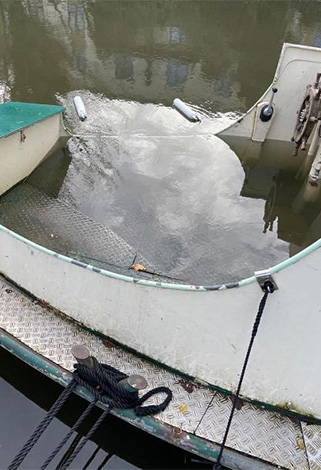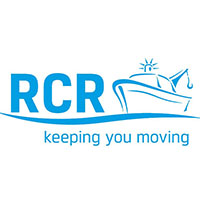storms sink boats
As storms continue to batter the UK, River Canal Rescue (RCR) is reporting an increase in the number of call-outs to recover submerged vessels. In October, Storm Babet alone, was responsible for 13 boats succumbing to rapidly rising water levels on the Caldon, Chesterfield, Leeds & Liverpool and Leicester Canals, the Rivers Great Ouse, Soar, Trent and Weaver, and in Leicester Marina.
RCR expects persistent heavy rainfall and storms to increase the number of vessels experiencing issues and says continually rising water levels will result in more divers needed to recover them.
“Boats either couldn’t cope with the deluge of rain, were unable to rise in line with increasing water levels due to too tight ropes, or in the case of one call-out, sunk after trying to turn in strong currents, ended up listing and catching a tree stump where water overwhelmed the vents,” comments managing director, Stephanie Horton.
“A number were swept down river when flood waters and flow increased, depositing them, semi-submerged and miles from their home location.”
RCR says in a seven-week period, starting the beginning of October, 35 vessels fell victim to storms Babet, Ciaran and Debi. “With our winters predicted to become even wetter, it’s important to prepare for stormy weather and check your insurance is adequate,” Stephanie continues.
Over 40% of the rescues RCR has attended have had claims denied for differing reasons, including some where salvage is not included in the cover.

"Be prepared," Stephanie adds: “While not all situations can be avoided, owners should check their mooring ropes are loose enough to cope with sudden changes in water levels, and if a mooring is at risk of flooding, run a rope to locations that can still be accessed even in a flood situation.
“To stop a vessel drifting onto land when water levels rise, position a scaffold pole or poles, or a
boarding plank, between the boat and the river/canal side edge and fix it into position. This acts as a mooring post, preventing flood waters from floating the boat onto land.”
Alongside weather-related emergencies, RCR reports badly-worn deck boards and leaking stern
glands are key contributors to water ingress.
Stephanie explains: “Engine bays covered by marine-ply deck boards are supported by a C-shaped steel channel with drain holes to collect any seeping rainwater. If the drain holes block with debris, leaves and dirt etc, water flows over the channel sides into the engine bay. Over time, the wooden deck boards decay, creating a wider gap between them, and so the downward spiral continues; more debris falls into the channel holes and more water flows into the engine bay. Prevent this by replacing worn deck boards and clearing drainage holes.
“If a stern gland leaks when the vessel is stationary, it can potentially flood the engine area. As this collar of rubber or brass forms a barrier where the propeller shaft exits the hull, it must be well-greased with tight packing. The grease should act as a seal while not in use and you can tighten it by adjusting the nut on the stern tube.
“If greasing and tightening the adjust bolts fails to slow the leak, the packing may need replacing. Address this fast; a quick build-up of water will cause the vessel to sink - even if you have a bilge pump, it will soon be overwhelmed.
“When the propeller shaft is turning, a stern gland should only leak a few drops a minute - it’s
difficult to be precise, as the amount is dependent on the gland’s age and type. However, water must circulate through the stern gland to keep it cool as the shaft turns. If you’re unsure what adjustment to make, check the stern gland temperature; if it’s too hot, the packing’s too tight.
Water spilling into the engine bay will cause the vessel to sit lower in the water, which in turn puts shower, sink or air outlets nearer to the water level, often with devastating results.”
Stephanie concludes: “Water ingress should not be a problem if you have a bilge pump. If possible, invest in an automatic one as it’s more reliable than a manual. Once left on the ‘automatic’ setting, its float switch dictates when it should pump, ensuring an immediate response to water ingress. And should a leak develop from elsewhere, such as the cooling system or hull, it will keep your vessel safe. However, if you’re leaving your boat for long periods you do need to regularly check on the battery.
“And if you have a bilge pump, install a bilge filter, such as Bilgeaway - this stops your boat pumping pollutants into the waterways.”
RCR’s filter, Bilgeaway, is the world’s first truly environmentally-friendly bilge discharge filter. It
extracts contaminants from bilge water, renders them non-reactive and leaves the contents in a
cartridge which can be disposed of and the housing re-used.

